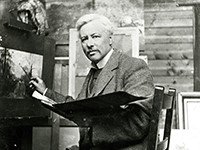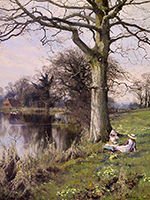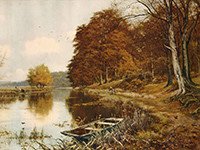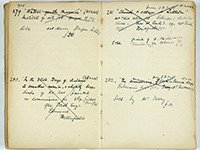 This month marks the 100th anniversary of the death of Edward Wilkins Waite, one of Surrey's less well-known painters but who produced in oils some of the county's most striking pictures.
This month marks the 100th anniversary of the death of Edward Wilkins Waite, one of Surrey's less well-known painters but who produced in oils some of the county's most striking pictures.
Waite's favourite subject was the countryside and he captured landscape scenes and vernacular architecture throughout the Surrey Weald and the Sussex and Berkshire Downs. He was born on 14 April 1854 in Leatherhead, where his father was the Congregationalist Minister and part of a literary and artistic circle which included George Macdonald, John Ruskin, Frederick Denison Maurice and John Brett. Edward senior was an amateur watercolourist and E W Waite's grandfather, William Watkin Waite (1778 to 1856), was a portrait miniaturist and also practised engraving and illustrating.
 E W Waite attended the Mansion House Grammar School in Leatherhead and later, in 1874, travelled to Canada, where he stayed for several months. On his return from Canada he embarked on a career as a professional artist and as early as 1878 exhibited a pen drawing and an oil painting at the Royal Academy, followed by a pair of pen drawings in 1880. He continued to show landscape and rural subjects in oils almost every year until 1919.
E W Waite attended the Mansion House Grammar School in Leatherhead and later, in 1874, travelled to Canada, where he stayed for several months. On his return from Canada he embarked on a career as a professional artist and as early as 1878 exhibited a pen drawing and an oil painting at the Royal Academy, followed by a pair of pen drawings in 1880. He continued to show landscape and rural subjects in oils almost every year until 1919.
In the 1880s, E W Waite lived and worked in Brockham and frequently used many of its well-known landmarks such as Noys End, Pondtail Farm and the River Mole in his paintings. Following his marriage in 1891 to Barbara Isabella Tait (1862 to 1950), one of the daughters of Sir Peter Tait (1828 to 1890), the couple moved to Abinger Hammer, later moving to Guildford, and in 1910 to Woolhampton in Berkshire.
 After a brief stay in Haslemere, the couple settled in Fittleworth in Sussex. Waite suffered badly with his mental health and was admitted to Holloway Sanatorium on two occasions as well as the Maudsley Hospital. He died in Camberwell House Asylum on 19 February 1924 and is buried in Fittleworth churchyard, as was his widow in 1950.
After a brief stay in Haslemere, the couple settled in Fittleworth in Sussex. Waite suffered badly with his mental health and was admitted to Holloway Sanatorium on two occasions as well as the Maudsley Hospital. He died in Camberwell House Asylum on 19 February 1924 and is buried in Fittleworth churchyard, as was his widow in 1950.
As Edward Wilkins Waite spent much of his life living and painting in Surrey, in 2010 the Waite archive was presented to Surrey History Centre in Woking by his grandson. The records include Waite's sketchbooks, photographs of Waite at work and with his family and a large quantify of contemporary photographs of landscape scenes taken by Waite to be used as an aide-memoir when transferring the scene to canvas.
 Perhaps most importantly, the 'Waite archive' includes the three notebooks in which Edward Wilkins Waite entered virtually every picture he painted from 1891. Waite started the first record book in May of that year, possibly on the initiative of his wife, Barbara, whom he had married in January. Some of the entries in the books are in her hand. The first notebook also includes paintings made before 1891 if they were then unsold and altogether 629 paintings are recorded. The information for each painting includes the number assigned to the work, its title, the size of the canvas (in inches, width before height), when and where it was exhibited or placed with a dealer for sale, and often the purchaser and the price obtained. Waite also recorded if he re-worked a picture before re-submitting for exhibition or sale.
Perhaps most importantly, the 'Waite archive' includes the three notebooks in which Edward Wilkins Waite entered virtually every picture he painted from 1891. Waite started the first record book in May of that year, possibly on the initiative of his wife, Barbara, whom he had married in January. Some of the entries in the books are in her hand. The first notebook also includes paintings made before 1891 if they were then unsold and altogether 629 paintings are recorded. The information for each painting includes the number assigned to the work, its title, the size of the canvas (in inches, width before height), when and where it was exhibited or placed with a dealer for sale, and often the purchaser and the price obtained. Waite also recorded if he re-worked a picture before re-submitting for exhibition or sale.
Images
Select image to view a larger version.
- Edward Wilkins Waite in his studio, circa 1914 (reference 8752/2/9/4)
- 'In Primrose Time' (Paddington Mill Pond, Abinger Hammer, 1892) (reference 8752/2/8/36)
- 'In the Still Days of Autumn' (believed to be a view of the River Wey just south of Guildford), 1908 (reference 8752/2/5/4)
- Record book entry for 'In the Still Days of Autumn', 1908 (reference 8752/2/2/2). The entry reads: 280. "In The Still Days of Autumn" (36" x 24). A smaller version, & slightly longer shape of No 240 painted as commission for Geo. Beck Esq: Elmwood Petersfield 45gns (including frame £3).

